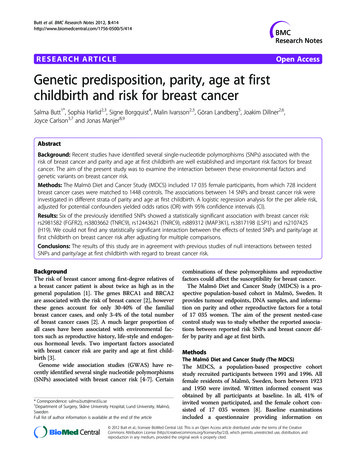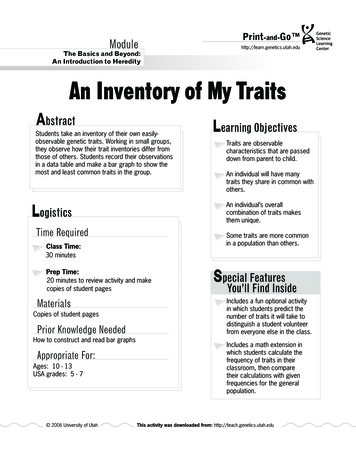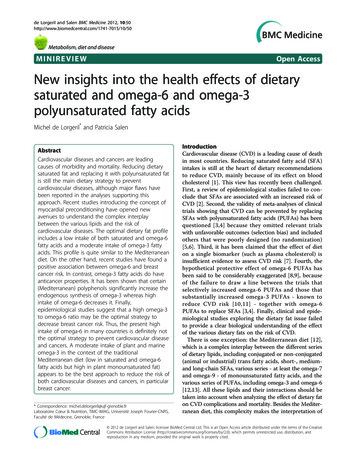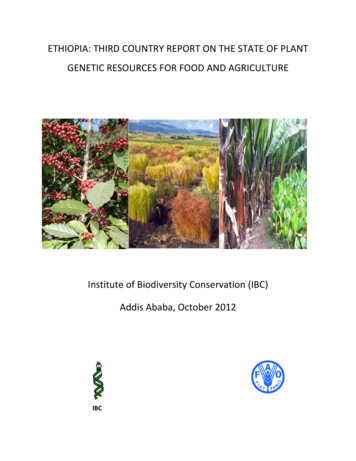
Transcription
Butt et al. BMC Research Notes 2012, ESEARCH ARTICLEOpen AccessGenetic predisposition, parity, age at firstchildbirth and risk for breast cancerSalma Butt1*, Sophia Harlid2,3, Signe Borgquist4, Malin Ivarsson2,3, Göran Landberg5, Joakim Dillner2,6,Joyce Carlson3,7 and Jonas Manjer8,9AbstractBackground: Recent studies have identified several single-nucleotide polymorphisms (SNPs) associated with therisk of breast cancer and parity and age at first childbirth are well established and important risk factors for breastcancer. The aim of the present study was to examine the interaction between these environmental factors andgenetic variants on breast cancer risk.Methods: The Malmö Diet and Cancer Study (MDCS) included 17 035 female participants, from which 728 incidentbreast cancer cases were matched to 1448 controls. The associations between 14 SNPs and breast cancer risk wereinvestigated in different strata of parity and age at first childbirth. A logistic regression analysis for the per allele risk,adjusted for potential confounders yielded odds ratios (OR) with 95% confidence intervals (CI).Results: Six of the previously identified SNPs showed a statistically significant association with breast cancer risk:rs2981582 (FGFR2), rs3803662 (TNRC9), rs12443621 (TNRC9), rs889312 (MAP3K1), rs3817198 (LSP1) and rs2107425(H19). We could not find any statistically significant interaction between the effects of tested SNPs and parity/age atfirst childbirth on breast cancer risk after adjusting for multiple comparisons.Conclusions: The results of this study are in agreement with previous studies of null interactions between testedSNPs and parity/age at first childbirth with regard to breast cancer risk.BackgroundThe risk of breast cancer among first-degree relatives ofa breast cancer patient is about twice as high as in thegeneral population [1]. The genes BRCA1 and BRCA2are associated with the risk of breast cancer [2], howeverthese genes account for only 30-40% of the familialbreast cancer cases, and only 3-4% of the total numberof breast cancer cases [2]. A much larger proportion ofall cases have been associated with environmental factors such as reproductive history, life-style and endogenous hormonal levels. Two important factors associatedwith breast cancer risk are parity and age at first childbirth [3].Genome wide association studies (GWAS) have recently identified several single nucleotide polymorphisms(SNPs) associated with breast cancer risk [4-7]. Certain* Correspondence: salma.butt@med.lu.se1Department of Surgery, Skåne University Hospital, Lund University, Malmö,SwedenFull list of author information is available at the end of the articlecombinations of these polymorphisms and reproductivefactors could affect the susceptibility for breast cancer.The Malmö Diet and Cancer Study (MDCS) is a prospective population-based cohort in Malmö, Sweden. Itprovides tumour endpoints, DNA samples, and information on parity and other reproductive factors for a totalof 17 035 women. The aim of the present nested-casecontrol study was to study whether the reported associations between reported risk SNPs and breast cancer differ by parity and age at first birth.MethodsThe Malmö Diet and Cancer Study (The MDCS)The MDCS, a population-based prospective cohortstudy recruited participants between 1991 and 1996. Allfemale residents of Malmö, Sweden, born between 1923and 1950 were invited. Written informed consent wasobtained by all participants at baseline. In all, 41% ofinvited women participated, and the female cohort consisted of 17 035 women [8]. Baseline examinationsincluded a questionnaire providing information on 2012 Butt et al.; licensee BioMed Central Ltd. This is an Open Access article distributed under the terms of the CreativeCommons Attribution License (http://creativecommons.org/licenses/by/2.0), which permits unrestricted use, distribution, andreproduction in any medium, provided the original work is properly cited.
Butt et al. BMC Research Notes 2012, arity, age at first childbirth, education, occupation,marital status, age at menarche, age at menopause, exposure to oral contraceptives (OC) (ever/never), currentuse of hormonal replacement therapy (HRT), alcoholconsumption and smoking habits [9]. HRT was definedas non-use, use of estrogen replacement therapy, progesterone replacement therapy or combined hormonalreplacement therapy. Information on gynecological surgery was collected from medical records and menopausal status was defined, using this informationtogether with data obtained from the questionnaire onmenstruations, as previously described in detail [10]. Atrained nurse at the study centre measured height andweight, and Body Mass Index (BMI) was calculated askg/m2 [9].The MDCS and the present analyses were approved bythe Ethical Committee at Lund University (LU 51–90,Dnr 652/2005 and Dnr 2009/682).Parity and age at first childbirthInformation on parity was assessed from the questionnaire. The question: “How many children have you givenbirth to and in what years were they born?” was categorised as; nullipara, one child, two children and threeor more children. Parity was further dichotomized asnulliparous and parous in order to yield larger groups.Age at first childbirth was calculated from the information provided in the same question and categorised as; 20, 20 - 25, 25 - 30 and 30. Age at first childbirthwas also dichotomized as 25 years of age and 25 yearsof age. Information on parity and age at first childbirthwas missing for a small number of women, and theywere excluded from all analyses. No reliable informationon twin pregnancies was available nor on miscarriagesor abortions.Follow-upAll women were followed until 31st of December 2007.Tumour end-points were retrieved by record linkagewith The Swedish Cancer Registry (until 31st of December 2006), and due to a delay in central registration, alsowith linkage to its regional branch, The Southern Swedish Regional Tumour Registry concerning 2007. Vitalstatus was obtained from The Swedish Cause-of-DeathRegistry until 31st of December 2007.Study populationAll 17035 women were followed for cancer as describedabove. For the purpose of the present study, only womenwith no previous (prevalent) cancer (not including cancer in situ of the uterine cervix) were eligible for inclusion. A total of 545 cases with incident breast cancerwere identified in a first set with follow-up until 31st ofDecember 2004. One case did not have any DNA samplePage 2 of 11hence this case was excluded. The remaining 544 caseswere matched to two controls each, a total of 1088. Thematching criteria were age ( / 90 days) and time ofsampling at baseline ( / 30 days). A new linkage wasperformed with follow-up until 31st of December 2007,where an additional 186 cases and 372 controls wereidentified. A total of 11 controls from the first set werediagnoses with breast cancer during the second followup period. They were removed as controls and replacedby other controls matched on the same criteria. For 14women, there were no DNA available for sampling (2cases and 12 controls); hence they were excluded fromall statistical analyses. Finally, the study population consisted of a total of 2176 women out of which 728 werecases and 1448 were controls.SNP selection and analysisEleven SNPs were selected from previous GWAS andcandidate SNP publications by Easton et al. (rs2981582(FGFR2), rs3803662 (TNRC9), rs12443621 (TNRC9),rs98051542 (TNRC), rs889312 (MAP3K1), rs3817198(LSP1), rs2107425 (H19), rs13281615 (8q24), rs981782(5p12), rs30099 (5q), rs4666451 (2p)) [4], one from Coxet al. (rs1045485 (CASP8)) [7], one from Stacey et al.(rs13387042 (2q35)) [5] and one from Harlid et al.(rs7766585 (ESR1)) [11]. The GWAS SNPs were chosenfrom studies published up until the 1st of July 2007.The tested SNPs were analysed in a previous largerdata set including other centres. For the current cohort,a screening and a verification test was performed in1605 individuals. The comparison showed concordantresults in 99% of analyses [11].The SNP analyses were performed with a MALDITOF mass spectrometer (SEQUENOM MassArray)using iPLEX reagents and protocol (SEQUENOM) and10 ng DNA as PCR template. Primer sets were fromMetabion (Martinsried, Germany). The laboratory methods have previously been described in detail [11].The genotypes for the SNPs were defined as: homozygous major allele (AA), heterozygote (Aa) and homozygous minor allele (aa). In cases with minor allelefrequency (MAF) near 0.5, the same classification as thatused in previous studies was used.Statistical methodsCases and controls were compared with regard to established and potential risk factors for breast cancer inorder to identify possible confounders.An unconditional binary logistic regression model wasfitted to analyse the association between SNPs andbreast cancer. A per allele analysis was performed usinga continuous variable with the values 0 (AA), 1 (Aa),and 2 (aa). The reported odds ratios (OR) with 95% confidence intervals (CI) denotes the risk difference when
Butt et al. BMC Research Notes 2012, age 3 of 11Table 1 Case–control status and distribution of potential confoundersFactorCategoryCase (n 728)Control (n 1448)Column% (n) Mean (SD) in italicsEducationO-level college67.9 (494)A-level college7.1 (52)7.0 (101)24.7 (180)22.4 (325)0.3 (2)0.3 (5)UniversityMissingType of occupationManual worker33.2 (242)38.5 (557)Non-manual worker60.0 (437)52.3 (757)5.5 (40)8.1 ng1.2 (9)1.1 (16)No33.7 (245)33.4 (483)Yes66.3 (483)66.6 (965)——MissingAge at menarcheParityAge at first childbirth 1220.9 (152)21.4 (310) 12 to 1552.2 (380)53.8 (779) 1526.0 (189)23.8 (344)Missing1.0 (7)1.0 (15)Nullipara11.5 (84)9.7 (141)119.8 (144)21.3 (309)244.6 (325)41.9 (607) 321.6 (157)24.8 (359)Missing2.5 (18)2.2 (32)Nullipara11.5 (84)9.7 (141) 2015.5 (113)16.2 (234) 20 to 2534.8 (253)36.3 (526) 25 to 3025.5 (186)26.7 (387) 3010.2 (74)8.8 (127)MissingBilateral oophorectomy2.5 (18)2.3 (33)No98.9 (720)98.3 (1424)Yes1.1 (8)1.7 (24)MissingPre-/PerimenopausalAge at menopause11.9 (172)11.5 (84)39.2 (567)37.4 (272) 5314.4 (209)14.3 (104)1.2 (18)2.2 (16)No46.8 (341)49.0 (709)Yes53.0 (386)50.8 (735)0.1 (1)0.3 (4)No, pre menopausal23.0 (167)21.1 (306)No, peri-/post menopausal49.3 (359)59.4 (860)ERT5.1 (37)6.3 (91)PRT1.2 (9)0.5 (7)21.2 (154)12.3 (178)CHRTMissingHeight—34.6 (252) 45 to 53MissingExposure to HRT (current/non)—33.3 (482) 45MissingExposure to OC (ever/never)70.2 (1017)Mean (standard deviation)Missing for both cases and controls0.3 (2)0.4 (6)164.3 (5.8)163.8 (6.0)
Butt et al. BMC Research Notes 2012, age 4 of 11Table 1 Case–control status and distribution of potential confounders (Continued)Body mass indexMean (standard deviation)25.6 (4.1)25.5 (4.4)Missing for both cases and controlsAlcohol consumptionNothing last year (teetotaler)10.2 (74)12.0 (174)Something last year (not last month)10.6 (77)12.1 (175)Something last month79.0 (575)75.6 (1094)MissingSmoking0.3 (2)0.3 (5)Never43.4 (316)43.2 (626)Current27.5 (200)28.1 (407)Ex29.1 (212)28.5 (413)0.0 (0)0.1 (2)Missingincreasing the number or risk alleles with one. Inaddition ORs were calculated using the common allele(AA) as reference group for risk estimates for the separate genotypes in all analyses.Parity and age at first birth was dichotomised as nulliparous vs. parous and 25 years of age at first childbirth vs. age 25 years of age at first childbirth.Overall breast cancer risk was calculated with the lowest groups as reference, adjusted for birth year andyear at baseline.The SNP analyses were stratified on nulliparous vs.parous women and on age 25 years of age at first childbirth vs. age 25 years of age at first childbirth. Parityand age at first childbirth were also studied in fourcategories.In addition, the material was stratified on single genotypes, and the breast cancer risk associated with parityand increasing age at first birth was calculated. Theseassociations were reported using the p-values for thecontinuous analysis.All analyses were subsequently adjusted for matchingcriteria, age and year of inclusion in study, and for potential confounders. A potential confounder was definedas a factor with a distribution difference exceeding 5%units between cases and controls and only these factorswere included in the multivariate analysis.In order to assess any potential interactions between selected SNPs and parity and betweenselected SNPs and age at first birth, an interactionterm was introduced in the logistic regressionmodel. A p-value 0.05 was considered statisticallysignificant. In a third step, the p-value was corrected for multiple comparisons according to Bonferroni, i.e. divided by the number of comparison.In the present study, performing 28 interaction analyses, the corrected p-value regarded as statisticallysignificant was 0.0018.As part of a sensitivity analysis, all analyses wererepeated excluding women with information on less than80% of SNPs in a single individual, as this may indicate apoor DNA quality. In these analyses 660 cases and 1310controls were included.ResultsCase–control status and distribution of potentialconfoundersAmong the described variables, cases were more oftennon-manual workers as compared to controls; 60% vs.52% (Table 1). More cases were users of HRT, particularly combined hormonal replacement therapy (CHRT),as compared to controls 21% vs. 12% (Table 1). Thesefactors differed by at least 5% units between cases andcontrols and were, hence, included in the multivariateanalyses. All other factors were similarly distributed between cases and controls.Selected SNPs in relation to breast cancer riskA breast cancer association was seen for six of the 14tested SNPs; rs2981582 (FGFR2) 1.28 (1.12-1.47),rs3803662 (TNRC9) 1.20 (1.04-1.39), rs12443621(TNRC9) 1.19 (1.04-1.35), rs889312 (MAP3K1) 1.18(1.02-1.36), rs3817198 (LSP1) 1.17 (1.10-1.35) andrs2107425 (H19) 0.86 (0.75-0.99) (Table 2).Selected reproductive risk factors in relation to breastcancer riskIn the analyses of breast cancer risk associated with thestudied reproductive factors, we could see a borderlinedecreased breast cancer risk for parous women as compared to nulliparous women RR: 0.82 (0.62-1.10). Forage at first birth, there was no breast cancer association( 25 years of age RR: 1.05 (0.87-1.28)).Selected SNPs and breast cancer risk according to parityand age at first birthOnly one interaction between the effects of the testedSNPs (rs981782 (5p12)) and parity was found with regard to breast cancer risk p 0.02 (Table 3). This association was not seen when stratifying on four paritygroups (Additional file 1: Appendix1). No association
Butt et al. BMC Research Notes 2012, age 5 of 11Table 2 Overall breast cancer risk in relation to selected SNPsSNP Rs number(Gene)Case/controlNBreast cancer riskCrude OR (CI 95%)Breast cancer riskAdjusted OR*(CI 95%)Breast cancerrisk AdjustedOR** (CI 95%)rs2981582 (FGFR2)CC233/5611.001.001.00CT356/6531.31 (1.08-1.60)1.31 (1.07-1.60)1.31 (1.07-1.61)TT124/185Per allele1.61 (1.23-2.12)1.62 (1.23-2.13)1.63 (1.23-2.16)1.28 (1.12-1.46)1.28 (1.12-1.46)1.28 (1.12-1.47)rs1045485 (CASP8)CC185/3741.001.001.00CG42/860.99 (0.66-1.49)0.98 (0.65-1.48)1.04 (0.69-1.58)GG8/101.62 (0.63-4.17)1.61 (0.63-4.16)1.73 (0.66-4.54)1.10 (0.79-1.51)1.10 (0.80-1.54)1.10 (0.79-1.54)Per allelers3803662 (TNRC9)CC353/7801.001.001.00CT278/5121.20 (0.99-1.46)1.20 (0.99-1.46)1.19 (0.98-1.45)TT64/951.49 (1.06-2.09)1.49 (1.06-2.10)1.47 (1.04-2.08)1.21 (1.05-1.40)1.21 (1.05-1.40)1.20 (1.04-1.39)Per allelers8051542 (TNRC9)CC192/4431.001.001.00CT338/6371.22 (0.99-1.52)1.23 (0.99-1.52)1.20 (0.97-1.50)TT149/2721.26 (0.97-1.64)1.27 (0.97-1.64)1.24 (0.95-1.62)1.13 (1.00-1.29)1.13 (1.00-1.29)1.12 (0.99-1.28)Per allelers12443621 (TNRC9)AA195/4511.001.001.00AG338/6571.19 (0.96-1.47)1.19 (0.96-1.47)1.20 (0.97-1.49)GG165/2751.39 (1.07-1.79)1.39 (1.08-1.79)1.42 (1.09-1.84)1.18 (1.04-1.34)1.18 (1.04-1.34)1.19 (1.04-1.35)Per allelers889312 (MAP3K1)AA322/7371.001.001.00AC301/5301.30 (1.07-1.58)1.30 (1.07-1.58)1.26 (1.03-1.53)CC66/118Per allele1.28 (0.92-1.78)1.28 (0.92-1.78)1.29 (0.92-1.80)1.19 (1.04-1.37)1.19 (1.04-1.37)1.18 (1.02-1.36)rs3817198 (LSP1)TT311/6681.001.001.00CT282/5551.09 (0.90-1.33)1.09 (0.90-1.33)1.06 (0.87-1.30)CC76/107Per allele1.53 (1.10-2.11)1.53 (1.11-2.11)1.50 (1.08-2.09)1.18 (1.02-1.36)1.18 (1.02-1.36)1.17 (1.10-1.35)rs2107425 (H19)CC361/6371.001.001.00CT250/5730.77 (0.63-0.94)0.77 (0.63-0.94)0.78 (0.64-0.95)TT68/145Per allele0.83 (0.60-1.14)0.83 (0.60-1.14)0.83 (0.60-1.14)0.86 (0.74-0.99)0.86 (0.74-0.99)0.86 (0.75-0.99)rs13281615 (8q24)AA245/5331.001.001.00AG332/6331.14 (0.93-1.40)1.14 (0.93-1.40)1.14 (0.93-1.40)GG117/2041.25 (0.95-1.64)1.25 (0.95-1.64)1.25 (0.95-1.64)1.12 (0.98-1.28)1.12 (0.98-1.28)1.15 (1.00-1.31)Per allele
Butt et al. BMC Research Notes 2012, age 6 of 11Table 2 Overall breast cancer risk in relation to selected SNPs (Continued)rs981782 (5p12)TT182/3351.001.001.00TG352/6850.95 (0.76-1.18)0.95 (0.76-1.18)0.91 (0.72-1.14)GG125/2960.78 (0.59-1.03)0.78 (0.59-1.03)0.74 (0.56-0.98)0.89 (0.77-1.02)0.89 (0.77-1.02)0.87 (0.75-1.00)Per allelers30099 (5q)CC584/11391.001.001.00CT113/2480.89 (0.70-1.13)0.89 (0.70-1.14)0.90 (0.71-1.16)TT11/121.79 (0.78-4.08)1.79 (0.78-4.10)1.79 (0.77-4.18)0.98 (0.79-1.21)0.98 (0.79-1.22)0.99 (0.80-1.24)Per allelers4666451 (2p)GG272/5541.001.001.00GA299/5741.06 (0.87-1.30)1.06 (0.87-1.30)1.08 (0.88-1.32)AA105/2041.05 (0.80-1.38)1.05 (0.79-1.38)1.06 (0.80-1.40)1.03 (0.91-1.18)1.03 (0.91-1.18)1.04 (0.91-1.19)Per allelers13387042 (2q35)AA192/3351.001.001.00AG330/6571.08 (0.86-1.36)1.08 (0.86-1.35)1.08 (0.86-1.37)GG163/3501.23 (0.95-1.59)1.23 (0.95-1.59)1.24 (0.96-1.62)0.90 (0.79-1.03)0.90 (0.79-1.03)0.90 (0.79-1.02)Per allelers7766585 (ESR1)CC518/10311.001.001.00CT172/3480.98 (0.80-1.22)0.98 (0.80-1.22)0.98 (0.79-1.21)TT17/261.30 (0.70-2.42)1.30 (0.70-2.42)1.42 (0.76-2.67)1.03 (0.86-1.23)1.03 (0.86-1.23)1.03 (0.86-1.24)Per allele* Adjusted for matching variables (age and year of inclusion in study).** Adjusted for matching variables (age and year of inclusion in study), and for selected confounders (socioeconomic status and exposure to HRT).between the tested SNPs and age at first birth was seenwith regard to breast cancer risk. Moreover, no statistically significant interaction between the effects of testedSNPs and parity/age at first childbirth on breast cancerrisk was seen after adjusting for multiple comparisons(using the corrected p-value cut-off 0.0018).In the per allele analyses, no clear patterns for riskassociations were seen in the stratified analyses (Table 3,Table 4, Additional file 1: Appendix 1 and Appendix 2).Sensitivity analysis including subjects with information onat least 80% of SNPsWhen including only women with information on atleast 80% of SNPs, the results were fairly similar in allanalyses but some analyses with borderline significantORs became significant when only individuals with information on 80% of all SNPs were analysed (data notshown).DiscussionThe results of this present study are in agreement withprevious GWAS studies for six out of 14 SNPs. With respect to breast cancer risk, there were no statisticallysignificant gene-environment interactions between parity/age at first childbirth and SNPs and this is in agreement with the results in three other large-scaleinvestigations [12-14].Methodological considerationsRepresentativityA total of 40% of the invited women in Malmö participated in the MDCS and women in the MDCS have beenshown to have a higher incidence of breast cancer andthey may also be selected towards a slightly highersocioeconomic status [8] than the general population.However, as the present study use internal comparisons,yielding relative risks rather than incidence rates, the impact of a potential selection bias was probably limited.Reproductive factorsParity and age at first birth were the main exposures ofthis study and were obtained from questionnairesanswered at baseline. All women were 44 years or olderat baseline, hence unlikely to have given birth to morechildren thereafter.
Butt et al. BMC Research Notes 2012, age 7 of 11Table 3 Breast cancer risk in relation to selected SNPs with regard to parityRs nr (Gene)rs2981582 (FGFR2)p-valueinter-actionCase/ control NNulliparous OR*(CI 95%)Case/ control NParous OR*(CI 95%)0.96CC30/521.00200/4931.00CT36/690.90 (0.48-1.69)310/5711.36 (1.09-1.69)TT16/151.88 (0.78-4.52)104/1671.55 (1.15-2.10)Per allelers1045485 (CASP8)1.25 (0.82-1.91)1.27 (1.10-1.46)0.93CC21/481.00162/3181.00CG7/141.08 (0.37-3.18)35/711.03 (0.65-1.63)GG0/0—8/10Per allelers3803662 (TNRC9)0.93 (0.31-2.83)1.68 (0.64-4.42)1.12 (0.79-1.58)0.58CC36/721.00311/6941.00CT33/541.32 (0.71-2.44)238/4461.17 (0.95-1.47)TT8/71.95 (0.61-6.29)54/82Per allelers8051542 (TNRC9)1.33 (0.83-2.14)1.47 (1.01-2.14)1.19 (1.02-1.40)0.15CC14/381.00177/3991.00CT41/661.56 (0.73-3.36)289/5581.14 (0.91-1.44)TT23/282.18 (0.93-5.14)120/234Per allelers12443621 (TNRC9)1.47 (0.96-2.24)1.14 (0.86-1.52)1.08 (0.94-1.24)0.95AA22/301.00170/4151.00AG35/790.68 (0.33-1.42)295/5651.28 (1.02-1.62)GG25/251.55 (0.67-3.61)135/237Per allelers889312 (MAP3K1)1.25 (0.82-1.92)1.43 (1.08-1.89)1.20 (1.04-1.38)0.11AA42/671.00273/6531.00AC33/590.83 (0.46-1.53)261/4611.31 (1.06-1.62)CC4/100.49 (0.14-1.77)61/1031.47 (1.03-2.09)Per allelers3817198 (LSP1)0.77 (0.48-1.24)TT37/68CTCC1.00271/5911.0031/551.12 (0.60-2.11)239/4821.06 (0.85-1.31)8/44.38 (1.13-16.96)68/100Per allelers2107425 (H19)1.24 (1.07-1.45)0.481.53 (0.93-2.51)1.48 (1.04-207)1.16 (0.99-1.35)0.12CC44/571.00311/5701.00CT27/570.54 (0.28-1.05)213/4980.80 (0.65-1.00)TT4/140.35 (0.11-1.19)64/1270.94 (0.67-1.31)Per allelers13281615 (8q24)0.58 (0.36-0.95)0.91 (0.78-1.06)1.00AA29/521.00211/465AG37/611.11 (0.58-2.15)290/5581.18 (0.95-1.47)GG13/191.32 (0.55-3.15)99/1831.26 (0.93-1.70)Per allele1.14 (0.75-1.73)1.001.13 (0.98-1.31)
Butt et al. BMC Research Notes 2012, age 8 of 11Table 3 Breast cancer risk in relation to selected SNPs with regard to parity (Continued)rs981782 (5p12)0.02TT15/381.00162/2901.00TG43/721.67 (0.79-3.53)303/5950.85 (0.67-1.09)GG14/162.66 (0.99-7.12)107/2730.65 (0.48-0.87)Per allelers30099 (5q)1.64 (1.01-2.67)CC66/101CTTT1.00505/101514/340.68 (0.32-1.43)97/2050.95 (0.73-1.24)2/13.18 (0.26-39.46)9/111.63 (0.66-4.06)Per allelers4666451 (2p)0.81 (0.70-0.94)0.470.89 (0.47-1.67)1.001.02 (0.81-1.30)0.37GG26/511.00237/4941.00GA38/541.39 (0.69-2.59)256/5021.08 (0.87-1.34)AA15/201.30 (0.54-3.10)88/1801.02 (0.75-1.38)Per allelers13387042 (2q35)1.17 (0.77-1.79)1.02 (0.89-1.18)0.79AA22/351.00164/2921.00AG40/601.11 (0.55-2.25)287/5800.87 (0.68-1.11)GG16/360.69 (0.30-1.61)140/308Per allelers7766585 (ESR1)0.85 (0.56-1.28)0.80 (0.60-1.06)0.89 (0.78-1.03)0.10CC63/971.00443/9071.00CT18/330.76 (0.39-1.51)150/3100.99 (0.79-1.24)TT0/6——17/201.91 (0.98-3.71)Per allele0.96 (0.82-1.12)1.03 (0.97-1.10)*Adjusted for: age, year of inclusion in study, socioeconomic status and exposure to HRT.SNP analysesSNP analysis method has been validated by repeatingthe analyses twice, in a subset and the reproducibilitywas very high [11]. In order to verify that the resultswere not altered by damaged DNA, the analyses wererepeated including only women with results on 80% ormore of the SNP analyses. Following this, all resultswere similar.Statistical powerOverall, the sample size of this study was fairly small,yielding a statistical power issue. Many comparisonswere made and there is a potential risk of a type I error.The replication of results concerning selected SNPs andbreast cancer risk was based on previous studies, and allbut one SNP showed associations in the expected direction (statistically significant for six out of 14 SNPs). Thisstrengthens the assumption that these results reflecttrue associations and were not only the result of multiple comparisons. As these analyses are made with ana priori hypothesis, the Bonferroni correction for multiple testing was not considered relevant. Concerninginteraction analyses and the stratified analyses, theseanalyses were exploratory and hypothesis generatinghence corrections for multiple comparisons for the performed interactions was considered valid. Due to fewindividuals in the analyses, the confidence intervalswere wide and the statistical power was low which canhave lead to a type II error. In order to address the riskof type II error, parity and age at first childbirth weredichotomized yielding larger study groups. Moreover,interaction term corrected for multiple comparisons(Bonferroni correction) yielded no statistically significant interactions.Previous studiesTo our knowledge, four studies have been publishedstudying breast cancer risk and the potential interactionbetween SNPs and parity/age at first childbirth [12-15].The SNP rs2981582 (FGR2), was studied by Kawase et al.and they found a high breast cancer risk for nulliparouswomen and for women giving birth to one or two children, carrying homozygote minor allele of rs2981582(FGR2). In their study, a total of 456 cases and 912
Butt et al. BMC Research Notes 2012, age 9 of 11Table 4 Breast cancer risk in relation to selected SNPs with regard to age at first child-birthRs nr (Gene)rs2981582 (FGFR2)p-valueinter-actionCase/ controlNAge 25 yearsOR* (CI 95%)Case/ controlNAge 25 yearsOR* (CI 95%)0.47CC110/2911.0090/2021.00CT191/3521.49 (1.20-1.99)119/2191.18 (0.84-1.66)TT60/951.68 (1.13-2.51)44/711.38 (0.87-2.20)Per allelers1045485 (CASP8)1.33 (1.10-1.61)1.17 (0.94-1.47)0.26CC104/1921.0058/1261.00CG21/410.99 (0.55-1.80)14/301.14 (0.55-2.34)GG3/70.88 (0.22-3.60)5/3Per allelers3803662 (TNRC9)0.93 (0.58-1.49)3.21 (0.71-14.61)1.38 25 (0.95-1.37)95/1881.08 (0.78-1.51)TT31/531.32 (0.81-2.16)23/29Per allelers8051542 (TNRC9)1.19 (0.97-1.46)1.72 (0.94-3.12)1.21 3 (0.91-1.65)123/2441.06 (0.73-1.53)TT68/1491.01 (0.70-1.46)52/85Per allelers12443621 (TNRC9)1.03 (0.86-1.23)1.36 (0.85-2.16)1.16 8 (1.10-2.01)126/2521.07 (0.74-1.55)GG79/1461.45 (1.01-2.08)56/91Per allelers889312 (MAP3K1)1.22 (1.02-1.46)1.39 (0.88-2.18)1.17 30 (0.99-1.71)100/1721.33 (0.95-1.86)CC37/681.38 (0.88-2.16)24/351.61 (0.91-2.86)Per allelers3817198 (LSP1)1.21 (1.00-1.48)TT160/359CTCC1.00111/232139/2871.05 (0.79-1.39)100/1951.04 (0.74-1.46)44/502.00 (1.27-3.14)24/491.00 (0.58-1.73)Per allelers2107425 (H19)1.30 (1.02-1.65)0.171.27 (1.04-1.55)1.001.02 69 (0.52-0.91)93/1940.99 (0.71-1.39)TT35/780.78 (0.50-1.22)29/491.19 (0.71-2.00)Per allelers13281615 (8q24)0.81 (0.66-0.99)1.06 7 (0.95-1.69)118/2341.04 (0.74-1.48)GG54/1071.25 (0.84-1.86)45/76Per allele1.15 (0.95-1.83)1.27 (0.80-2.01)1.11 (0.89-1.39)
Butt et al. BMC Research Notes 2012, age 10 of 11Table 4 Breast cancer risk in relation to selected SNPs with regard to age at first child-birth (Continued)rs981782 (5p12)0.38TT88/1731.0074/1171.00TG185/3510.96 (0.70-1.32)118/2430.73 (0.50-1.06)GG67/1690.71 (0.48-1.05)40/1040.60 (0.37-0.96)Per allelers30099 (5q)0.85 (0.70-1.03)CC299/621CTTT1.00206/39354/1081.02 (0.71-1.46)43/970.83 (0.55-1.25)6/62.47 (0.77-7.91)3/50.76 (0.16-3.62)Per allelers4666451 (2p)0.77 (0.61-0.980.311.14 (0.83-1.56)1.000.85 23 (0.92-1.64)97/2070.89 (0.63-1.26)AA53/1091.11 (0.75-1.65)35/710.90 (0.56-1.45)Per allelers13387042 (2q35)1.09 (0.91-1.31)0.93 (0.74-1.17)0.89AA95/1681.0069/1241.00AG170/3480.86 (0.63-1.19)117/2320.89 (0.61-1.30)GG84/1860.80 (0.55-1.15)56/121Per allelers7766585 (ESR1)0.89 (0.74-1.07)0.84 (0.54-1.31)0.92 7 (0.80-1.43)51/1100.88 (0.60-1.29)TT11/132.06 (0.89-4.75)6/71.68 (0.55-5.19)Per allele1.07 (0.98-1.18)0.98 (0.90-1.08)*Adjusted for: age, year of inclusion in study, socioeconomic status and exposure to HRT.controls were included which is comparable to the presentstudy; however they only included one SNP [15].The study by Travis et al. examined 120 geneenvironmental interactions (i.e. reproductive, behavioural,and anthropometric risk factors for breast cancer) categorising parity as nulliparous vs. parous and age at first childbirth as younger or older than 25 years of age in 7610cases and 10 196 controls, making the results less vulnerable to type II error. They studied 12 SNPs and did notfind any statistically significant interaction. Four of theSNPs examined in the present study (rs8051542 (TNRC9),rs12443621 (TNRC9), rs2107425 (H19) and rs7766585(ESR1)) were not studied by Travis et al. [12].Milne et al. studied ten GWAS SNPs and two candidate SNPs associated with breast cancer in 26349 invasive breast cancer cases and 32208 controls with regardto interaction with reproductive factors. After adjustment for multiple comparisons no significant associationwas seen for parity (continuous and categorical) or ageat first childbirth (continuous and categorical). Five ofthe studied SNPs by Milne et al. are the same as inthis study: rs2981582 (FGFR2), rs889312 (MAP3K1),rs3817198 (LSP1), rs13281615 (8q24) and rs13387042(2q35). The other seven SNPs studied by Milne et al.have been studied in more recent GWAS studies and arehence not included in the presen
a breast cancer patient is about twice as high as in the general population [1]. The genes BRCA1 and BRCA2 are associated with the risk of breast cancer [2], however these genes account for only 30-40% of the familial breast cancer cases, and only 3-4% of the total number of breast cancer cases [2]. A much larger proportion of











